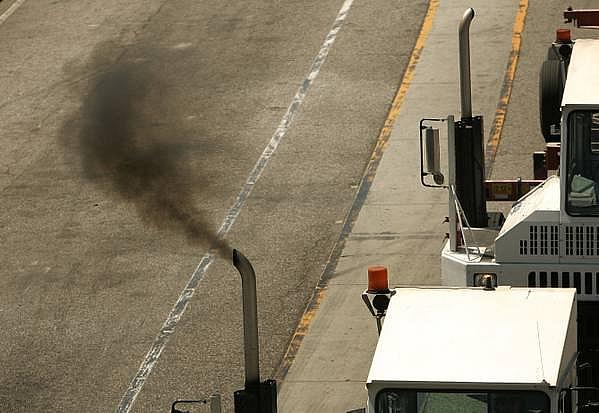Emerging Science Reveals Toxicity of Dirty Air

Exhaust fumes are released into the air from a truck at the BNSF Railway San Bernardino Yard. STAN LIM/STAFF PHOTOGRAPHER
This is the second of two posts looking at the health effects of air pollution in Southern California’s Inland Empire. Here is the first post.
Southern California’s Inland Empire has a big problem with bad air. As Press-Enterprise environmental reporter David Danelski explained recently in his “Air of Risk” series*, smog-trapping geography conspires with a booming cargo and warehouse industry to create toxic air pollutants that routinely blow past federal standards. Even as the region has made gains from the smoggy nadir of the ’60s and ’70s, pollution continues to exact a heavy toll on the health of residents, with children often hit the hardest.
While my last post broadly sketched the region’s struggle to balance air quality against a recovering cargo economy, some of the most fascinating (and disturbing) reading in Danelski’s series includes his reporting on what some of the newer science is telling us about the potential health consequences of breathing compromised air. The risks, in turns out, go way beyond asthma epidemics and itchy, red eyes.
Take for instance new research showing associations air pollution and autism. A UCLA study of 7,000 women in L.A. County found that prenatal exposure to higher levels of air pollution was associated with a 12 to 15 percent increased risk of having an autistic child, Danelski reports. A separate USC study found that autistic children were more likely to have had the highest prenatal exposure to traffic pollution through the first year of life.
In June, Harvard researchers reached a similar conclusion. Danelski writes:
Based on a nationwide study, Harvard scientists found that women who live in areas with polluted air have as much as twice the chance of giving birth to an autistic child than those living in communities with cleaner air.
Other studies have linked air pollution to low birth weights and pre-term births.
Even as they age, children’s risk of pollution-related maladies continues, according to Ed Avol, an expert on the health effects of air pollution at USC’s Keck School of Medicine, where he is a professor of clinical medicine. He says that’s because children spend more time outdoors, often running around and playing, and they also tend breathe more air relative to their body size. Kids also don’t know when to take precautions when air quality is particularly bad. When pollution does enter their lungs, it can have more harmful consequences than it might in adults, according to Avol. And early-life exposure to pollution can have lasting effects.
“We know from studies that have been done that if you have a poorer start and have poor lung function throughout your life, you’re at higher risk for heart disease … and a higher risk for early death,” Avol told a crowd of concerned residents at a recent forum on air pollution in Riverside.
According to Avol, air pollution has been found to stunt lung development. “Children that grow up in higher pollution areas have slower growing lungs,” he said. “The amount of that decline is about 1 to 1.5 percent a year. But over the course of many years of growing, that becomes a big deal.”
That slower rate of growth can add up by the time a child turns 18. And Avol says those living within a quarter-mile of freeways are losing lung function the fastest.
In San Bernardino and Riverside counties, the sources of air pollution are legion: miles of freeways, two major airports, around-the-clock diesel truck traffic, freight trains, the nation’s largest ports just to the west, and fast-spreading tracts of warehouses. On top of that, the intense ultraviolet sunlight in the region actually “cooks” some of the trapped emissions, forging new toxic compounds known as “secondary pollutants” in the atmosphere.
Researchers are still mapping all the ways in which those pollutants compromise health.
Some early new research has indicated that severe pollution exposure can change children’s brain function in ways typically not seen until much later in life. Danelski cites the work of a researcher at the University of Montana, Lilian Calderón-Garcidueñas, who examined the brains of children and found that those exposed to high levels of pollution exhibited brain changes similar to early-stage Parkinson’s and Alzheimer’s.
Another intriguing new research angle looks at the possible link between air pollutants and obesity. Danelski summarizes one study conducted by researchers at Columbia University among pregnant African-American and Hispanic women, which tracked their pollutant exposure during the third trimester. The children with prenatal exposure to polycyclic aromatic hydrocarbons (air toxins commonly released by burning carbon-based fuels) were twice as likely as the other children in the study to be obese by their seventh birthday:
The authors said laboratory studies have shown that PAHs interfere with the process of lipolysis, the breaking down of fats inside the body. The less fat a person can break down, the more it stays in the body.
As Avol cautions in Danelski’s story, the science is far from settled on some of the links between pollution and obesity or brain changes, and it’ll take further research to say with confidence that air toxins cause or even contribute to some of these newly discovered health risks.
But the larger scientific consensus is clear: Air pollution poses serious, lasting health risks, especially for kids. The human costs are worth keeping in mind as residents and officials consider some of the massive new warehouse complexes currently proposed for the region.
“Early life changes have lifelong consequences,” Avol told residents last week. “And the choices you’re going to make in the next couple years actually will affect the health of children and the general public’s health.”
* Danelski's reporting was produced in part with a grant from the Lucile Packard Foundation for Children's Health Journalism Fund, awarded by The California Endowment Health Journalism Fellowships at the USC Annenberg School of Journalism.
